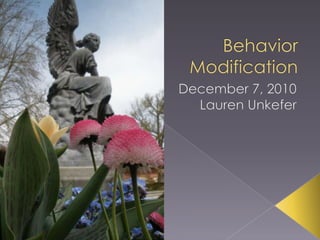
Behavior Modification
- 1. December 7, 2010 Lauren Unkefer Behavior Modification
- 2. Outline What it is Benefits Steps involved What it looks like Arguments against
- 3. What it is Behavior Modification: Techniques involving environmental manipulations to change behavior. (Martin, 1999)
- 4. What it is Subcategories: Applied behavior analysis (ABA) Behavior therapy(Kearney, 2008)
- 5. Benefits Provides a classroom behavior plan Quick and easy It works(Martin, 1999)
- 6. Steps involved Screening Base-line Treatment Follow-up(Martin, 1999)
- 7. Screening Identify problembehavior Discover cause(Martin, 1999)
- 8. Screening: Problem Behavior Identify problem behavior Deficits or excesses Patterns(Martin, 1999)
- 9. Screening: Cause Functional Assessment Cause Attention Self-stimulation Environmental consequences Escape Respondents How assess?(Martin, 1999)
- 10. Question
- 11. Baseline Baseline: amount of desired behavior occurrences in a normal setting. Define desired behavior Collect data (Martin, 1999)
- 12. Baseline: Desired Behavior Define(Martin, 1999) Use cause Intervention Elimination Positive
- 14. Question
- 15. Treatment Treatment: the solution in action. Plan Purpose: to encourage desired behavior.(Martin, 1999)
- 16. Treatment:The Plan Includes Method to publically record behavior Reinforcement
- 17. Plan Example: Symbols Names on board Symbols (points) Positive: * (+3) Negative: / (-2) Record points Reinforce(Rockwell, 1993)
- 18. Plan Example: Daily Point Sheet Set goals Record accomplishments Reinforce Play money Class “store”(Rockwell, 1993)
- 19. Treatment:Reinforce Item Rewards Candy Marshmallows Erasers Games Notebooks Stickers(Rockwell, 1993)
- 20. Treatment:Reinforce Social Rewards Painting Clay Computer Listening to CDs(Rockwell, 1993) Verbal Reinforcement
- 21. Question
- 22. Follow-up Data: solution working? Reversal-Replication (ABAB) Research design Multiple-Baseline design across behaviors(Martin, 1999)
- 23. Follow-up: Reversal-Replication Baseline Treatment Reversal Treatment(Martin, 1999)
- 24. Follow-up:Multiple-Baseline Baseline (multiple subjects) Begin treatment with one subject If it works, add another subject(Martin, 1999)
- 26. What it looks like … Classroom http://www.youtube.com/watch?v=XroJtR9gQc8 Single student http://www.youtube.com/watch?v=im04U9Be4mA&feature=related
- 27. Negatives Bribery(Rockwell, 1993) Ignores bad behavior(Kearney, 2008) Behavior focus(Mars Hill Church)
- 28. Review What it is Benefits Steps involved What it looks like Arguments against
- 29. References astrid447. (2008, October 29) ABA Therapy for Autism [Video file]. Retrieved from http://www.youtube.com/user/astrid447 Biffle, Chris. (2007,November 08) Whole Brain Teaching: 6th Grade, Classroom Management [Video file]. Retrieved from http://www.youtube.com/user/ChrisBiffle#p/u/3/XroJtR9gQc8 Kearney, A.J. (2008). Understanding Applied Behavior Analysis, (27-28;84-86). Philadelphia, PA: Thomson-Shore, Inc. Mars Hill Church (2008, February 12) Destroying Behavior Modification [Video file]. Retrieved from http://www.youtube.com/user/mhcseattle#p/search/2/VHj6Jm7Y5Ek Martin, G., & Pear, J. (1999). Behavior modification: What it is and how to do it. Upper Saddle River, N.J: Prentice Hall. Rockwell, S. (1993). Tough to reach, though to teach: Students with behavior problems, (27-39;55). Reston, Virginia: The Council for Exceptional Children.
Notas do Editor
- Use plan to either prevent the stimuli of the problem behavior from taking place or replace the problem behavior with a desirable behavior